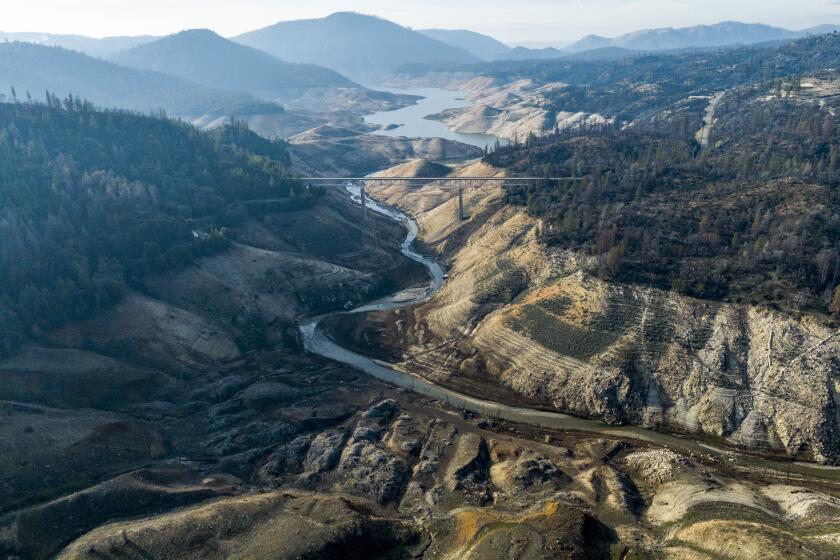California’s October heat wave is winding down. Will it finally start feeling like fall again?

- Share via
After almost a week of record-breaking high temperatures, Californians should begin to see some relief from the oppressive October heat wave that has broiled inland areas — and even some coastal regions — across the state.
A cooling trend is forecast to begin Tuesday and continue through the rest of the week, as the unrelenting ridge of high pressure that has been positioned over the southwestern U.S. begins to shift eastward.
“There’s a light at the end of the tunnel,” the National Weather Service in the Bay Area wrote on X on Monday, with most heat advisories across the state set to expire by Tuesday morning.
That’s not to say that temperatures will immediately drop to an autumn-like chill, but thermometers across the state are expected to slowly decrease from their unseasonable highs, which in many areas have been 20 degrees above average for this time of year.
The month kicked off with triple-digit temperatures in many parts of the state, with millions of Californians under heat advisories through at least Thursday.
“We could expect above-average temperatures to definitely linger, at least for the next week, but not that record-breaking heat that we have been seeing,” said Kyle Wheeler, a National Weather Service meteorologist in San Diego. “By the end of the week and getting into the weekend, it will definitely feel like fall — relatively speaking.”
Until that cooling trend begins, inland communities across the state will continue to see significant heat through Monday night — with excessive heat warnings still cautioning about triple-digit highs — before the gradual cooling begins. Most areas are forecast to be drop closer to seasonal averages by the weekend, Wheeler said.
The recent heat wave has demonstrated “a big gradient” between coastal areas and inland valleys, deserts and mountains, especially in Southern California, said Rose Schoenfeld, a National Weather Service meteorologist in Oxnard. Much of the Los Angeles, Orange and San Diego county coasts haven’t experienced the effects of this heat wave, due to a strong marine layer.
But California’s interior certainly has been sweltering.
On Sunday, Indio set the state’s highest temperature for the latest calendar date, at 116 degrees. That high, also reached in Ocotillo Wells, was the hottest temperature anywhere in the contiguous U.S., according to the National Weather Service.
Throughout the hot weekend, temperature records were shattered from Ukiah to Ramona, and practically everywhere in between, including in the Antelope Valley, the southeast desert and the Bay Area. In the Central Valley, Fresno, Merced, Hanford and Madera all set all-time highs for the month of October last week, hitting 105 or 106 degrees on Oct. 3.
Las Vegas has already reached 100 degrees or higher for six days in October — every day so far — which meteorologists have noted is typically rare to occur throughout the entire month.
The excessive heat that lasted for days was the result of what officials have called an unusual pattern of uninterrupted high pressure — rare for this time of year, though not unheard of.
“These unusually strong ridging or troughing patterns will set up in different areas of the world and we just happen to be directly under it here,” Wheeler said.
Without any other systems to interfere, such as an incoming low-pressure system, Schoenfeld said that ridge of the high pressure system, simply, just sat over the southwest. High pressure systems in the upper atmosphere typically drive all of California’s major heat waves, creating a lid over an area as air sinks — a phenomenon sometimes referred to as a heat dome — which prevents hot air from rising, essentially trapping it. High pressure systems also suppress cloud formation, which allows for more direct sunlight.
The climate pattern could plunge California back into aridity in the months ahead.
“There just wasn’t anything significant enough to knock it down,” she said.
But even with the most extreme temperatures set to drop, Schoenfeld said California will remain in a “stagnantly warm weather pattern.” The Climate Predication Center shows a high probability that the Golden State — and the entire western U.S. — will see above-average temperatures through the end of October.
More to Read
Sign up for Essential California
The most important California stories and recommendations in your inbox every morning.
You may occasionally receive promotional content from the Los Angeles Times.













